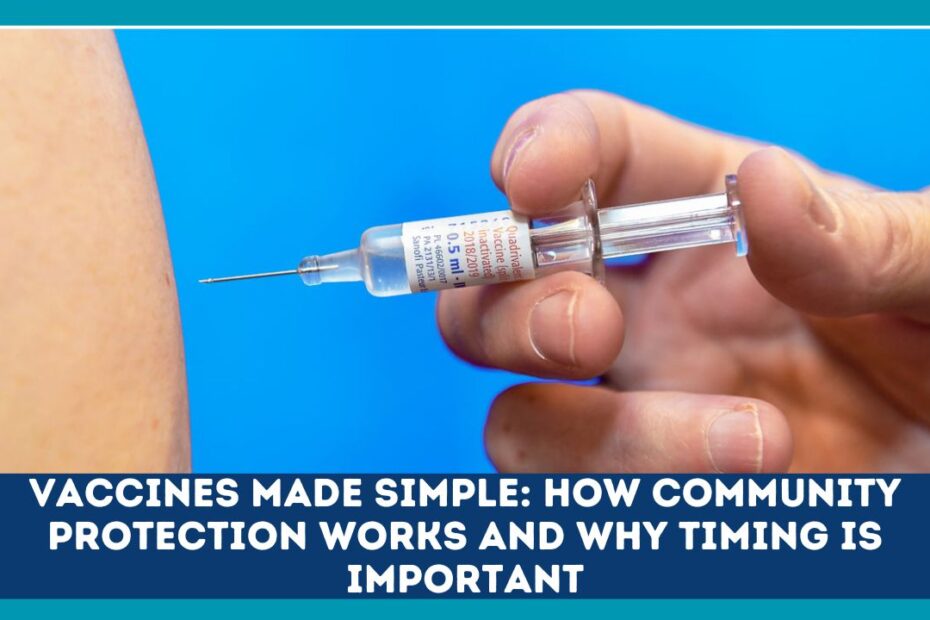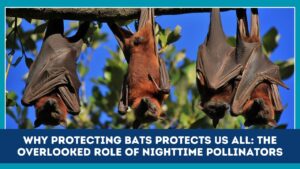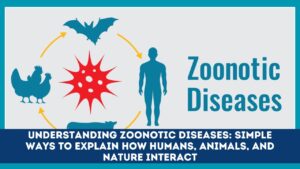A vaccine is a biological preparation that trains the immune system to recognize and combat pathogens without causing disease.
Through methods like weakened or inactivated organisms, surface proteins, or novel RNA platforms, vaccines stimulate immune memory in a safe way.
They are one of the most effective tools in public health, helping to drastically reduce, and in some cases eliminate, deadly diseases.
Vaccines not only protect individuals but also strengthen community immunity, making society safer for everyone—including people who cannot be vaccinated due to age or health conditions.
How Community Protection (Herd Immunity) Works
Herd immunity—or community protection—occurs when a large portion of a population becomes immune, significantly reducing disease spread and protecting those who remain vulnerable.
Consider it like a forest fire: if too many trees are “flammable,” the fire spreads. But when most trees are “fire-proof,” the fire dies out.
This concept safeguards infants too young for vaccination, immunocompromised individuals, and those with medical allergies.
Once enough people are immune, transmission chains are broken, reducing outbreaks.Herd immunity thresholds differ by disease: measles requires around 94–95% immunity, while polio needs around 80%.
Why Timing Is Crucial
Timing matters greatly when it comes to vaccination. Some vaccines need multiple doses—known as a primary series—spaced correctly to build long-lasting protection.
The first dose starts the process; subsequent doses enhance and sustain immunity. Health authorities stress administering vaccines at recommended ages and intervals for maximum efficacy.
Delaying vaccines can leave individuals and communities vulnerable to outbreaks.
For instance, during Australia’s post‑COVID vaccine fatigue, immunization coverage fell below the 95% target.
Rates dropped especially in some NSW communities—under 75% in parts—resulting in a resurgence of whooping cough, flu, RSV, and measles. Timely vaccination is essential to prevent such scenarios.
Real-World Impacts & Patterns of Disease
When high vaccination rates are maintained:
- Smallpox was eradicated.
- Polio is nearly eliminated globally.
- Measles cases in the U.S. dropped from hundreds of thousands in 1958 to fewer than 150 per year after vaccine deployment. Vaccination now prevents approximately one million measles deaths annually.
The WHO estimates routine vaccination prevents 3.5–5 million deaths annually, and over the last 50 years, prevented around 154 million deaths, including 146 million in children under 5.
Special Strategies & Additional Protection
- Contact immunity: With the oral live-attenuated polio vaccine (OPV), recently vaccinated individuals can shed the weakened virus, indirectly vaccinating close contacts. Around 25% of contacts gained protection this way. But due to rare risks (about 1 in 2.4 million), many countries now favor inactivated polio vaccines (IPV).
- Ring vaccination: Used against Ebola in the DRC’s Kivu outbreak, delivering targeted vaccination to close contacts reduced transmission by 97.5% in over 90,000 people vaccinated.
Challenges: Hesitancy & Communication
Vaccine hesitancy poses a huge threat to herd immunity and disease control. WHO even lists hesitancy among the top ten global health threats. Delaying or refusing vaccines has caused disease resurgence and deaths.
To combat this:
- Educate and debunk myths respectfully.
- Communicate simply and trustworthily.
- Use combo vaccines to reduce injections and parental overwhelm.
Key Insights
| Aspect | Details |
|---|---|
| Definition of Vaccine | Prepares immune system safely using weakened/killed components or RNA |
| Herd Immunity | Community-level protection when enough are immune (e.g. 94–95% for measles) |
| Importance of Timing | Correct dosing schedule ensures maximum, long-lasting protection |
| Real‑World Impact | Millions of lives saved annually; diseases eradicated or dramatically reduced |
| Contact & Ring Strategies | Secondary protection via OPV shedding (25%); Ebola ring vaccination 97.5% effective |
| Vaccine Hesitancy Challenges | Declining rates lead to outbreaks; countered via education & empathetic dialogue |
Vaccination is more than just individual protection—it’s a collective shield.
When vaccines are administered at the right time, following recommended schedules, they not only protect the recipient but also strengthen community resilience through herd immunity.
Strategically timed and widespread vaccination has eradicated fatal diseases, prevented millions of deaths, and continues to save lives worldwide.
In the face of rising hesitancy and threats, staying informed and staying on schedule are vital. Vaccines truly make protection simple—and powerful.
Frequently Asked Questions
1. What is the minimum vaccination coverage needed for herd immunity?
Different diseases require different thresholds. For example, measles needs 94–95% immunity, while polio requires around 80%.
2. Why can’t we delay vaccinations until later if coverage drops?
Delayed vaccines mean prolonged vulnerability—both for the individual and the community. Proper spacing—especially in multi‑dose series—is essential for strong, lasting immunity.
3. What are effective ways to overcome vaccine hesitancy?
Combining clear communication, trust-building (especially through healthcare providers), simplifying schedules (e.g., combination shots), and humane education helps counter hesitancy and misinformation.



